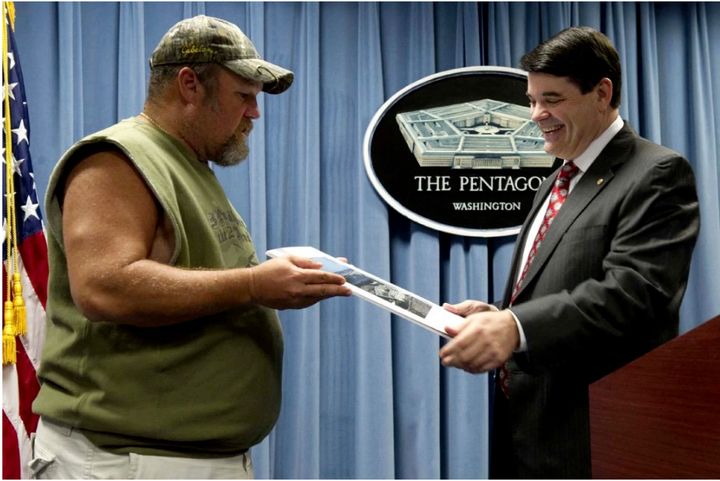You know the cherubic, sleeveless gentleman who appears on television to sell you heartburn medication or remind you to “Git-R-Done”? Well, he replied to one of my Tweets and my whole life changed.
OK, half of that is true.
Last month, a high-level Pentagon official could no longer countenance that a nanny would dare park without a permit in his posh neighborhood (where she worked). So, naturally, he stole her license plates. To accompany the story, the Washington Post chose a picture of the suspect, Principal Deputy Assistant Secretary of Defense Bryan Whitman, presenting a challenge coin to comedian Larry the Cable Guy.

I emailed it to my friend Jason who immediately spotted Mr. Cable Guy and replied:
“You should tweet this at Larry the Cable Guy!”
“Haha, yeah,” I replied, dismissively.
“I’m serious, you want followers? This is how you get them!”
#TheDarkSide
I did want followers, but I was wary of what I had to do to get them. Would it involve selfies?
Up until about a year ago, I didn’t do social. You know, in the millennial sense, where social is a noun now.
I had a Twitter account but I only tweeted once — profoundly typing “AERFDAADFFDAA” with my right buttock in 2013.
The only non-media account I followed was my friend Jason.
Jason has the social media habits of a much younger man. He often sends comments to random celebrities — from NFL wide receiver Nate Burleson to an actor who appeared in three episodes of his favorite show 24. When being polite, I’d say I didn’t understand it enough to judge. More often, I’d judge and say a lot more.
When I quit my job last October to write full-time, I felt I had to embrace social media but had no clue where to begin. I looked at hundreds of articles on social media strategy, filling my head with more contradictory tips than a back-issue of Golf Digest in a dentist’s waiting room.
Jason began to offer advice – solicited or not. The exchange resembled a cliché halftime speech scene. He’d ask repeatedly if I wanted followers. Once I screamed “YES!”, he’d send over his latest idea, concluding with: “This is how you get them.”
After a few stagnant months, I started to get over myself and listened to more of Jason’s advice.
I swallowed hard, rolled up my sleeves, and sent this tweet to a man who had none:
I sighed, releasing the ghost of the small part of me that just died.
#DataDataData
One thing I like about social media is all the data. It’s allowed a gentle transition from the analytics career I left behind.
When you send a tweet, there are three main data points: audience, impressions, and engagements.
Audience is how many users could possibly see your tweet. This is the sum of your total followers and the followers of anyone who retweets your tweet.
Impressions are how many times someone sees your tweet. It could be someone actively reading, scrolling mindlessly, or surrendering their phone to a small, fussy child.
An engagement refers to every time someone clicks on your tweet. Maybe they just expanded it to read the whole thing. Or, just maybe they clicked through to your site and fell in love.
When you start converting these raw numbers into rates, it gets depressing.
Let’s say I’m giving a presentation to a room of 200 people. I’m up there yammering and 70% of the room isn’t paying attention. They’re talking amongst themselves, wandering around the room, texting – completely clueless that I’m up there saying anything.
The remaining 60 people are at least silent and facing forward. They’re aware of my existence, but most have that look on their face like they’re reconsidering all the life decisions that led them to this speech.
Except for the three people who are engaged, nodding, and asking questions. They’re excited to go back and tell their friends and coworkers about that one thing I said about how, when you really think about it, life is just like a latte.
A presentation like this is an unmitigated disaster in real life, but a triumph on Twitter. Many would kill for a 5% engagement rate. According to a 2015 Forrester study, the top 25 brands on Twitter averaged a measly 0.035% engagement rate on their tweets.
#HelloWorld?
Social media is imperative for writers. It can get you an audience who will do the hard work of marketing for you. They’ll tell two friends. And then they’ll tell two friends. And so on. And so on. You know how these things go.
That’s how the myth goes, anyway. I’ve found the reality is quite different.
If the internet gave everyone a voice, social media took away their ears.
Studies show people use social media to validate their existence and boost their self-worth. They post hoping someone, anyone will respond. Taking time to consume what others produce and validate other people’s existences is secondary at best.
When it is done, it’s strategic. People use retweets to seem smart or supportive – perhaps expecting or fulfilling a quid pro quo. They use mentions and replies to join conversations in which they hope to be valued or at least draw in someone valuable.
And that’s exactly what I did.
#MissionAccomplished
I mentioned Larry the Cable Guy in my tweet because if he replies or retweets, I will potentially appear on the screens of his 415K followers. Like telemarketing and scams from Nigerian Princes, statistically some of them will read it and continue on to read more of what I write. Theoretically, anyway.
Once, I tweeted about an article from the humor magazine McSweeney’s. They retweeted it, sending my pithy comment to the timelines of their 253K followers. But in the end, only 8K saw my tweet, 20 clicked on it (half just to expand it), and only 2 bothered to click and see who this @frenchpressthry clown was. I gained no followers as a result.
Still, I was pretty excited when I saw this:
I sent Jason an only half-mocking text exclaiming “WE DID IT!” I was more excited that someone famous had read what I wrote (even if it was only 91 characters) than what it might mean for my readership.
I even sent Larry a reply back, because you know, we’re friends now. It wasn’t my best work, but I was trying to strike while the iron was hot.
Turns out there was no need to rush.
I can’t tell how many followers saw Mr. Cable Guy’s reply. But I can tell you that the initial tweet and my reply netted just over 400 total views. There was no increase in traffic on my site. The two new followers I got that day were from an unrelated tweet.
#NotYouItsMe
Reflecting on Twitter’s 10th anniversary, co-founder Evan Williams phrased the platform’s driving question thusly: “What can we do for you today that makes your life better by telling you something you didn’t know or giving you the opportunity to connect with someone?”
Admittedly, it’s a bit sanctimonious – surely Twitter knows how much of their traffic is generated by egotistical self expression. But this musing captures the lofty goal Twitter, and all social media platforms, had from the start. They were to be this generation’s printing press — the platform that would spread information, ideas and culture across the globe.
Social media saw the problem of parochialism and assumed the cause was inadequate access. We wanted to learn something new but didn’t know where to find it. Twitter solved this by allowing everyone, not just media and elites, to contribute to the conversation.
The gap between Twitter’s intention and how we use it highlights the true cause of our insularity. It gives us the opportunity to listen, but we speak. We could learn, but instead teach. Twitter could help us challenge our beliefs, but we’d rather double down.
Twitter isn’t the cause of this self-absorbed self-importance, but merely its most visible manifestation and perpetual enabler. Even before Twitter, we already knew we could sift through a billion voices and find none quite as mellifluous as our own.
Twitter may have shown us that there are many ways to do something, but all along we knew ours was the only way to “Git-R-Done!”
For more from Tim, check out French Press Theory.
